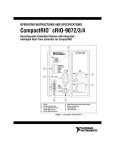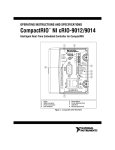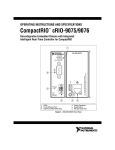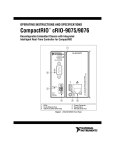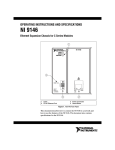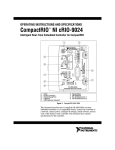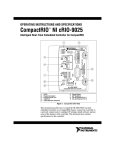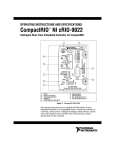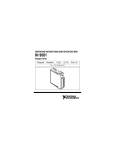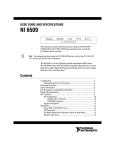Download CompactRIO cRIO-9072/3/4 Operating Instructions and Specifications
Transcript
OPERATING INSTRUCTIONS AND SPECIFICATIONS CompactRIO cRIO-9072/3/4 ™ Reconfigurable Embedded Chassis with Integrated Intelligent Real-Time Controller for CompactRIO 2 1 NI cRIO-9074 POWER FPGA STATUS USER1 SAFE MODE CONSOLE OUT IP RESET NO APP USER1 NO FPGA 8 LINK 7 RESET 3 2 10/ 100 V LINK INPUT 19-30 V 20 W MAX C NC 4 1 C 10/ 100 TRIGGER 6 1 2 3 4 5 LEDs RS-232 Serial Port RJ-45 Ethernet Port 2 (cRIO-9074 Only) RJ-45 Ethernet Port 1 5 6 7 8 SMB Connector (cRIO-9074 Only) Power Connector Reset Button DIP Switches Figure 1. CompactRIO cRIO-9072/3/4 This document describes how to connect the cRIO-9072/3/4 to a network and how to use the features of the cRIO-9072/3/4. This document also contains specifications for the cRIO-9072/3/4. Safety Guidelines Operate the cRIO-9072/3/4 only as described in these operating instructions. Safety Guidelines for Hazardous Locations The cRIO-9072/3/4 is suitable for use in Class I, Division 2, Groups A, B, C, D, T4 hazardous locations; Class 1, Zone 2, AEx nL IIC T4 and Ex nL IIC T4 hazardous locations; and nonhazardous locations only. Follow these guidelines if you are installing the cRIO-9072/3/4 in a potentially explosive environment. Not following these guidelines may result in serious injury or death. Caution Do not disconnect the power supply wires and connectors from the controller unless power has been switched off. Caution Substitution of components may impair suitability for Class I, Division 2. Caution For Zone 2 applications, install the CompactRIO system in an enclosure rated to at least IP 54 as defined by IEC 60529 and EN 60529. Special Conditions for Hazardous Locations Use in Europe Some chassis have been evaluated as Ex nL IIC T4 equipment under DEMKO Certificate No. 07 ATEX 0626664X. Each such chassis is marked II 3G and is suitable for use in Zone 2 hazardous locations, in ambient temperatures of –20 ≤ Ta ≤ 55 °C. Special Conditions for Marine Applications Some chassis are Lloyd’s Register (LR) Type Approved for marine applications. To verify Lloyd’s Register certification, visit ni.com/ certification and search for the LR certificate, or look for the Lloyd’s Register mark on the chassis. cRIO-9072/3/4 Operating Instructions and Specifications 2 ni.com What You Need to Install CompactRIO Reconfigurable Embedded Hardware ❑ CompactRIO reconfigurable embedded chassis with integrated intelligent real-time controller ❑ C Series I/O modules ❑ DIN rail mount kit (for DIN rail mounting only) ❑ Two M4 or number 10 panhead screws (for panel mounting only) ❑ A number 2 Phillips screwdriver ❑ Power supply Notes Visit ni.com/info and enter the Info Code rdsoftwareversion to determine which software you need to use the cRIO-9072/3/4. The cRIO-9072/3/4 may be shipped with a clear protective film cover on the front panel. You can remove the film cover before installing the cRIO-9072/3/4. Mounting the CompactRIO Reconfigurable Embedded Chassis You can mount the chassis in any orientation on a 35 mm DIN rail or on a panel. Use the DIN rail mounting method if you already have a DIN rail configuration or if you need to be able to quickly remove the CompactRIO chassis. Use the panel mount method for high shock and vibration applications. Your installation must meet the following requirements for space and cabling clearance: Caution • Allow 25.4 mm (1 in.) on the top and the bottom of the chassis for air circulation. • Allow 50.8 mm (2 in.) in front of modules for cabling clearance for common connectors, such as the 10-terminal, detachable screw terminal connector, as shown in Figure 2. © National Instruments Corporation 3 cRIO-9072/3/4 Operating Instructions and Specifications Cabling Clearance 50.8 mm (2.00 in.) 29.0 mm (1.14 in.) 48.4 mm (1.91 in.) 58.9 mm (2.32 in.) 286.4 mm (11.28 in.) 3.3 mm (0.13 in.) Figure 2. cRIO-9072/3/4, Bottom View with Dimensions 165.1 mm (6.50 in.) 19.0 mm (0.75 in.) NI cRIO-9074 36.4 mm (1.43 in.) 87.3 mm (3.44 in.) 51.1 mm (2.04 in.) 3.1 mm (0.12 in.) Figure 3. cRIO-9072/3/4, Front View with Dimensions cRIO-9072/3/4 Operating Instructions and Specifications 4 ni.com 3X M4X0.7 23.7 mm (0.94 in.) 44.1 mm (1.74 in.) 25 mm (0.98 in.) 44 mm (1.73 in.) 63.1 mm (2.48 in.) Figure 4. cRIO-9072/3/4, Side View with Dimensions The following sections contain instructions for the mounting methods. Before using any of these mounting methods, record the serial number from the back of the chassis. You will be unable to read the serial number after you have mounted the chassis. Caution Make sure that no I/O modules are in the chassis before mounting it. Mounting the Chassis on a Panel You can use the NI 9905 panel mount kit to mount the cRIO-9072/3/4 on a flat surface. Complete the following steps. 1. © National Instruments Corporation Fasten the chassis to the panel mount kit using a number 2 Phillips screwdriver and two M4 × 16 screws. National Instruments provides these screws with the panel mount kit. You must use these screws because they are the correct depth and thread for the panel. 5 cRIO-9072/3/4 Operating Instructions and Specifications 074 NI IO-9 cR Figure 5. Installing the Panel Mount Accessory on the cRIO-9072/3/4 311.2 mm (12.25 in.) 9.5 mm (0.38 in.) 330.2 mm (13.00 in.) 28.1 mm (1.11 in.) 15.5 mm (0.61 in.) NI cRIO-9074 31.8 mm (1.25 in.) 63.5 mm (2.50 in.) 88.1 mm (3.47 in.) Figure 6. Dimensions of cRIO-9072/3/4 with Panel Mount Accessory Installed 2. Caution Fasten the NI 9905 panel to the wall using the screwdriver and screws that are appropriate for the wall surface. Make sure that no I/O modules are in the chassis before removing it from the panel. cRIO-9072/3/4 Operating Instructions and Specifications 6 ni.com Mounting the Chassis on a DIN Rail You can order the NI 9915 DIN rail mount kit if you want to mount the chassis on a DIN rail. You need one clip for mounting the chassis on a standard 35 mm DIN rail. Complete the following steps to mount the chassis on a DIN rail. 1. Fasten the DIN rail clip to the chassis using a number 2 Phillips screwdriver and two M4 × 16 screws. National Instruments provides these screws with the DIN rail mount kit. Figure 7. Installing the DIN Rail Clip on the cRIO-9072/3/4 © National Instruments Corporation 7 cRIO-9072/3/4 Operating Instructions and Specifications 2. Insert one edge of the DIN rail into the deeper opening of the DIN rail clip, as shown in Figure 8. 1 2 3 1 DIN Rail Clip 2 DIN Rail Spring 3 DIN Rail Figure 8. One Edge of the DIN Rail Inserted in a Clip 3. Caution Press down firmly on the chassis to compress the spring until the clip locks in place on the DIN rail. Make sure that no I/O modules are in the chassis before removing it from the DIN rail. Installing C Series I/O Modules in the Chassis Figure 9 shows the mechanical dimensions of C Series I/O modules. 88.1 mm (3.47 in.) 70.7 mm (2.78 in.) 22.9 mm (0.90 in.) Figure 9. C Series I/O Module, Front and Side View with Dimensions cRIO-9072/3/4 Operating Instructions and Specifications 8 ni.com Complete the following steps to install a C Series I/O module in the chassis. 1. Make sure that no I/O-side power is connected to the I/O module. If the system is in a nonhazardous location, the chassis power can be on when you install I/O modules. 2. Align the I/O module with an I/O module slot in the chassis as shown in Figure 10. The module slots are labeled 1 to 8, left to right. 4 907 NI IO- cR 1 2 1 Insertion Groove 2 Latch Figure 10. Installing an I/O Module in the Chassis 3. Squeeze the latches and insert the I/O module into the module slot. 4. Press firmly on the connector side of the I/O module until the latches lock the I/O module into place. 5. Repeat these steps to install additional I/O modules. © National Instruments Corporation 9 cRIO-9072/3/4 Operating Instructions and Specifications Removing I/O Modules from the Chassis Complete the following steps to remove a C Series I/O module from the chassis. 1. Make sure that no I/O-side power is connected to the I/O module. If the system is in a nonhazardous location, the chassis power can be on when you remove I/O modules. 2. Squeeze the latches on both sides of the module and pull the module out of the chassis. Connecting the Chassis to a Network Connect the chassis to an Ethernet network using RJ-45 Ethernet port 1 on the controller front panel. Use a standard Category 5 (CAT-5) or better shielded, twisted-pair Ethernet cable to connect the chassis to an Ethernet hub, or use an Ethernet crossover cable to connect the chassis directly to a computer. Caution To prevent data loss and to maintain the integrity of your Ethernet installation, do not use a cable longer than 100 m. If you need to build your own cable, refer to the Cabling section for more information about Ethernet cable wiring connections. The first time you power up the chassis, the BIOS network settings determine the initial IP settings and other network behavior. After powerup, you must install software on the chassis and configure the network settings in Measurement & Automation Explorer (MAX). Installing software may change the network behavior of the chassis. For information about network behavior by installed software version, go to ni.com/info and enter the Info Code ipconfigcrio. Note The BIOS network settings of the cRIO-9072/3/4 depend on the part number of the chassis. The part number is located on the bottom of the chassis. BIOS Network Settings of cRIO-9072/3/4 with Part Number Beginning 192172 If the part number of the cRIO-9072/3/4 begins with 192172, the IP address, subnet mask, DNS address, gateway, and Time Server IP are all set to 0.0.0.0 at powerup. cRIO-9072/3/4 Operating Instructions and Specifications 10 ni.com The host computer communicates with the chassis over a standard Ethernet connection. If the host computer is on a network, you must configure the chassis on the same subnet as the host computer. If neither the host computer nor the chassis is connected to a network, you can connect the two directly using a crossover cable. If you want to use the chassis on a subnet other than the one the host computer is on, first connect the chassis on the same subnet as the host computer. Use DHCP to assign an IP address or reassign a static IP address for the subnet where you want it to be and physically move it to the other subnet. BIOS Network Settings of cRIO-9072/3/4 with Part Number Beginning 198944 If the part number of the cRIO-9072/3/4 begins with 198944, the chassis attempts to initiate a DHCP network connection at powerup. If the chassis is unable to initiate a DHCP connection, it connects to the network with a link-local IP address with the form 169.254.x.x. The host computer communicates with the chassis over a standard Ethernet connection. If neither the host computer nor the chassis is connected to a network, you can connect the two directly using a crossover cable. Wiring Power to the Chassis The cRIO-9072/3/4 requires an external power supply that meets the specifications in the Power Requirements section. The cRIO-9072/3/4 filters and regulates the supplied power and provides power for all of the I/O modules. The cRIO-9072/3/4 has one layer of reverse-voltage protection. Complete the following steps to connect a power supply to the chassis. 1. © National Instruments Corporation Connect the positive lead of the power supply to the V terminal of the COMBICON power connector shipped with the cRIO-9072/3/4, and tighten the terminal screw. Figure 11 shows the terminal screws, which secure the wires in the screw terminals, and the connector screws, which secure the power connector on the front panel. 11 cRIO-9072/3/4 Operating Instructions and Specifications 2 1 1 Terminal Screws V1 C V2 C 2 2 Connector Screws Figure 11. COMBICON Power Connector Caution 2. Connect the negative lead of the power supply to one of the C terminals of the power connector and tighten the terminal screw. 3. Optionally, you can connect the positive lead of another power supply to the other V terminal and the negative lead to one of the C terminals. 4. Install the power connector on the front panel of the cRIO-9072/3/4 and tighten the connector screws. The C terminals are internally connected to each other. Powering On the cRIO-9072/3/4 When you apply power to the cRIO-9072/3/4, the controller runs a power-on self test (POST). During the POST, the Power and Status LEDs turn on. The Status LED turns off, indicating that the POST is complete. If the LEDs do not behave in this way when the system powers on, refer to the Understanding LED Indications section. You can configure the cRIO-9072/3/4 to launch an embedded stand-alone LabVIEW RT application each time you boot the controller. Refer to the Running a Stand-Alone Real-Time Application (RT Module) topic of the LabVIEW Help for more information. cRIO-9072/3/4 Operating Instructions and Specifications 12 ni.com Chassis Reset Options Table 1 lists the reset options available on CompactRIO systems such as the cRIO-9072/3/4. These options determine how the chassis behaves when the controller is reset in various conditions. Use the RIO Device Setup utility to select reset options. Access the RIO Device Setup utility by selecting Start»All Programs»National Instruments»NI-RIO» RIO Device Setup. Table 1. CompactRIO Reset Options Chassis Reset Option Behavior Do not autoload VI Does not load the FPGA bit stream from flash memory. Autoload VI on device powerup Loads the FPGA bit stream from flash memory to the FPGA when the controller powers on. Autoload VI on device reboot Loads the FPGA bit stream from flash memory to the FPGA when you reboot the controller either with or without cycling power. Connecting Serial Devices to the cRIO-9072/3/4 The cRIO-9072/3/4 has an RS-232 serial port to which you can connect devices such as displays or input devices. Use the Serial VIs to read from and write to the serial port from a LabVIEW RT application. For more information about the Serial VIs, refer to the LabVIEW Help. Pin 6 Pin 1 Pin 9 Pin 5 Figure 12. Controller Serial Port © National Instruments Corporation 13 cRIO-9072/3/4 Operating Instructions and Specifications Table 2. DB-9 Pin Descriptions Pin Signal 1 DCD 2 RXD 3 TXD 4 DTR 5 GND 6 DSR 7 RTS 8 CTS 9 RI Using the Internal Real-Time Clock The system clock of the cRIO-9012/9014 is synchronized with the internal high-precision real-time clock at startup. This synchronization provides timestamp data to the controller. You can also use the internal real-time clock to correct drift of the system clock. Refer to the Internal Real-Time Clock specification in the Specifications section for the accuracy specifications of the real-time clock. Using the SMB Connector for Digital I/O (cRIO-9074 Only) You can use the SMB connector of the cRIO-9074 to connect digital devices to the controller. For example, if you connect the pulse-per-second output of a GPS device to the SMB connector of the cRIO-9074, you can use the GPS device to correct for drift of the system clock. For software that supports GPS drift-correction and other digital I/O through the SMB connector, go to ni.com/info and enter the Info Code criosmb. cRIO-9072/3/4 Operating Instructions and Specifications 14 ni.com Configuring DIP Switches 1 OFF 2 3 4 5 6 SAFE MODE CONSOLE OUT IP RESET NO APP USER1 NO FPGA Figure 13. DIP Switches All of the DIP switches are in the OFF position when the chassis is shipped from National Instruments. SAFE MODE Switch The position of the SAFE MODE switch determines whether the embedded LabVIEW Real-Time engine launches at startup. If the switch is in the OFF position, the LabVIEW Real-Time engine launches. Keep this switch in the OFF position during normal operation. If the switch is in the ON position at startup, the cRIO-9072/3/4 launches only the essential services required for updating its configuration and installing software. The LabVIEW Real-Time engine does not launch. If the software on the controller is corrupted, you must put the controller into safe mode and reformat the controller drive. You can put the controller into safe mode by powering it up either with the SAFE MODE switch in the ON position or with no software installed on the drive. Refer to the Measurement & Automation Explorer Help for more information about installing software on a controller and reformatting the drive on the controller. CONSOLE OUT Switch With a serial-port terminal program, you can use the CONSOLE OUT switch to read the IP address and firmware version of the controller. Use a null-modem cable to connect the serial port on the chassis to a computer. Push the switch to the ON position. Make sure that the serial-port terminal program is configured to the following settings: • 9,600 bits per second • Eight data bits • No parity © National Instruments Corporation 15 cRIO-9072/3/4 Operating Instructions and Specifications • One stop bit • No flow control The serial-port terminal program displays the IP address and firmware version of the chassis. Keep this switch in the OFF position during normal operation. IP RESET Switch Push the IP RESET switch to the ON position and reboot the controller to reset the IP address and other TCP/IP settings of the controller to the factory defaults. Refer to the Troubleshooting Network Communication section for more information about resetting the IP address. You also can push this switch to the ON position to unlock a chassis that was previously locked in MAX. NO APP Switch Push the NO APP switch to the ON position to prevent a LabVIEW RT startup application from running at startup. If you want to permanently disable a LabVIEW RT application from running at startup, you must disable it in LabVIEW. To run an application at startup, push the NO APP switch to the OFF position, create an application using the LabVIEW Application Builder, and configure the application in LabVIEW to launch at startup. If you already have an application configured to launch at startup and you push the NO APP switch from ON to OFF, the startup application is automatically enabled. For more information about automatically launching VIs at startup and disabling VIs from launching at startup, refer to the Running a Stand-Alone Real-Time Application (RT Module) topic of the LabVIEW Help. USER1 Switch You can define the USER1 switch for your application. To define the purpose of this switch in your embedded application, use the RT Read Switch VI in your LabVIEW RT embedded VI. For more information about the RT Read Switch VI, refer to the LabVIEW Help. NO FPGA Switch Push the NO FPGA switch to the ON position to prevent a LabVIEW FPGA application from loading at startup. The NO FPGA switch overrides the CompactRIO reset options described in the Chassis Reset Options section. After startup you can download to the FPGA from software regardless of switch position. cRIO-9072/3/4 Operating Instructions and Specifications 16 ni.com Using the RESET Button Pressing the RESET button resets the processor in the same manner as cycling power. Note The FPGA continues to run unless you select the Autoload on Any Device Reset boot option. Refer to the Chassis Reset Options section for more information. Understanding LED Indications POWER FPGA STATUS USER1 Figure 14. cRIO-9072/3/4 LEDs POWER LED The POWER LED is lit while the cRIO-9072/3/4 is powered on. This LED indicates that the power supply connected to the chassis is adequate. FPGA LED You can use the FPGA LED to help debug your application or easily retrieve application status. Use the LabVIEW FPGA Module and NI-RIO software to define the FPGA LED to meet the needs of your application. Refer to LabVIEW Help for information about programming this LED. © National Instruments Corporation 17 cRIO-9072/3/4 Operating Instructions and Specifications STATUS LED The STATUS LED is off during normal operation. The cRIO-9072/3/4 indicates specific error conditions by flashing the STATUS LED a certain number of times every few seconds, as shown in Table 3. Table 3. Status LED Indications Number of Flashes Every Few Seconds Indication 1 The chassis is unconfigured. Use MAX to configure the chassis. Refer to the Measurement & Automation Explorer Help for information about configuring the chassis. 2 The chassis has detected an error in its software. This usually occurs when an attempt to upgrade the software is interrupted. Reinstall software on the chassis. Refer to the Measurement & Automation Explorer Help for information about installing software on the chassis. 3 The chassis is in safe mode because the SAFE MODE DIP switch is in the ON position or there is no software installed on the chassis. Refer to the Configuring DIP Switches section for information about the Safe Mode DIP switch. 4 The software has crashed twice without rebooting or cycling power between crashes. This usually occurs when the chassis runs out of memory. Review your RT VI and check the memory usage. Modify the VI as necessary to solve the memory usage issue. Continuously flashing The chassis has detected an unrecoverable error. Contact National Instruments. Continuously flashing or solid The device may be configured for DHCP but unable to get an IP address because of a problem with the DHCP server. Check the network connection and try again. If the problem persists, contact National Instruments. USER1 LED You can define the USER1 LED to meet the needs of your application. To define the LED, use the RT LEDs VI in LabVIEW. For more information about the RT LEDs VI, refer to the LabVIEW Help. cRIO-9072/3/4 Operating Instructions and Specifications 18 ni.com Troubleshooting Network Communication If the cRIO-9072/3/4 cannot communicate with the network, you can perform the following troubleshooting steps. 1. Move the IP RESET switch to the ON position. 2. Push the RESET button to cycle power to the chassis. 3. Configure the IP and other network settings in MAX. 4. Move the IP RESET switch to the OFF position. The network behavior of the chassis after powering up with the IP RESET switch on depends on the version of LabVIEW RT installed. For information about the different network behaviors with different software versions, go to ni.com/info and enter the Info Code ipconfigcrio. Note If you are unable to fix network communication with the LabVIEW RT network settings restored, you can restore the BIOS network settings of the chassis. Refer to the Connecting the Chassis to a Network section of this document for information about the BIOS network settings for different chassis revisions. Complete the following steps to restore the BIOS network settings of the chassis. 1. Move the IP RESET and SAFE MODE switches to the ON position. 2. Push the RESET button to cycle power to the chassis. 3. Configure the IP and other network settings in MAX. 4. Move the IP RESET and SAFE MODE switches to the OFF position. If the chassis is restored to the BIOS network settings, the LabVIEW run-time engine does not load. You must reconfigure the network settings and restart the chassis for the LabVIEW run-time engine to load. Note © National Instruments Corporation 19 cRIO-9072/3/4 Operating Instructions and Specifications Specifications The following specifications are typical for the –20 to 55 °C operating temperature range unless otherwise noted. Network Network interface ...................................10BaseT and 100BaseTX Ethernet Compatibility ..........................................IEEE 802.3 Communication rates ..............................10 Mbps, 100 Mbps, auto-negotiated Maximum cabling distance.....................100 m/segment RS-232 Serial Port Maximum baud rate................................115,200 bps Data bits ..................................................5, 6, 7, 8 Stop bits ..................................................1, 2 Parity.......................................................Odd, Even, Mark, Space Flow control............................................RTS/CTS, XON/XOFF, DTR/DSR SMB Connector (cRIO-9074 Only) Output Characteristics Minimum high-level output voltage With –100 μA output current ..........2.9 V With –16 mA output current............2.4 V With –24 mA output current............2.3 V Maximum low-level output voltage With 100 μA output current ............0.10 V With 16 mA output current..............0.40 V With 24 mA output current..............0.55 V Driver type ..............................................CMOS cRIO-9072/3/4 Operating Instructions and Specifications 20 ni.com Maximum sink/source current ............... ±24 mA Maximum 3-state output leakage current ....................................... ±5 μA Input Characteristics Minimum input voltage.......................... 0 V Minimum low-level input voltage.......... 0.94 V Maximum high-level input voltage........ 2.43 V Maximum input voltage ......................... 5.5 V Typical input capacitance....................... 2.5 pF Typical resistive strapping ..................... 1 kΩ to 3.3 V Memory cRIO-9072, cRIO-9073 Nonvolatile...................................... 128 MB minimum System memory .............................. 64 MB cRIO-9074 Nonvolatile...................................... 256 MB minimum System memory .............................. 128 MB For information about the life span of the nonvolatile memory and about best practices for using nonvolatile memory, go to ni.com/info and enter the Info Code SSDBP. Reconfigurable FPGA cRIO-9072 Number of logic cells...................... 17,280 Available embedded RAM ............. 432 kbits cRIO-9073, cRIO-9074 Number of logic cells...................... 46,080 Available embedded RAM ............. 720 kbits For information about the life span of the nonvolatile memory and about best practices for using nonvolatile memory, go to ni.com/info and enter the Info Code SSDBP. © National Instruments Corporation 21 cRIO-9072/3/4 Operating Instructions and Specifications Internal Real-Time Clock Accuracy .................................................200 ppm; 35 ppm at 25 °C Power Requirements You must use a UL Listed ITE power supply marked LPS with the cRIO-9072/3/4. Caution Recommended power supply..................48 W, 24 VDC Power consumption ................................20 W maximum Power supply input range .......................19 to 30 V Physical Characteristics If you need to clean the controller, wipe it with a dry towel. Screw-terminal wiring ............................0.5 to 2.5 mm 2 (24 to 12 AWG) copper conductor wire with 10 mm (0.39 in.) of insulation stripped from the end Torque for screw terminals.....................0.5 to 0.6 N · m (4.4 to 5.3 lb · in.) Weight ....................................................929 g (32.7 oz) Safety Voltages Connect only voltages that are within these limits. V terminal to C terminal .........................35 V max, Measurement Category I Measurement Category I is for measurements performed on circuits not directly connected to the electrical distribution system referred to as MAINS voltage. MAINS is a hazardous live electrical supply system that powers equipment. This category is for measurements of voltages from specially protected secondary circuits. Such voltage measurements include signal levels, special equipment, limited-energy parts of equipment, circuits powered by regulated low-voltage sources, and electronics. Caution Do not connect the system to signals or use for measurements within Measurement Categories II, III, or IV. cRIO-9072/3/4 Operating Instructions and Specifications 22 ni.com Safety Standards This product meets the requirements of the following standards of safety for electrical equipment for measurement, control, and laboratory use: • IEC 61010-1, EN 61010-1 • UL 61010-1, CSA 61010-1 Note For UL and other safety certifications, refer to the product label or the Online Product Certification section. Electromagnetic Compatibility This product meets the requirements of the following EMC standards for electrical equipment for measurement, control, and laboratory use: • EN 61326 (IEC 61326): Class A emissions; Industrial immunity • EN 55011 (CISPR 11): Group 1, Class A emissions • AS/NZS CISPR 11: Group 1, Class A emissions • FCC 47 CFR Part 15B: Class A emissions • ICES-001: Class A emissions For the standards applied to assess the EMC of this product, refer to the Online Product Certification section. Note Note For EMC compliance, operate this product according to the documentation. CE Compliance This product meets the essential requirements of applicable European Directives as follows: • 2006/95/EC; Low-Voltage Directive (safety) • 2004/108/EEC; Electromagnetic Compatibility Directive (EMC) Online Product Certification Refer to the Declaration of Conformity (DoC) for this product for additional regulatory compliance information. To obtain product certifications and the DoC for this product, visit ni.com/ certification, search by model number or product line, and click the appropriate link in the Certification column. © National Instruments Corporation 23 cRIO-9072/3/4 Operating Instructions and Specifications Environmental Management National Instruments is committed to designing and manufacturing products in an environmentally responsible manner. NI recognizes that eliminating certain hazardous substances from our products is beneficial to the environment and to NI customers. For additional environmental information, refer to the NI and the Environment Web page at ni.com/environment. This page contains the environmental regulations and directives with which NI complies, as well as other environmental information not included in this document. Waste Electrical and Electronic Equipment (WEEE) EU Customers At the end of the product life cycle, all products must be sent to a WEEE recycling center. For more information about WEEE recycling centers, National Instruments WEEE initiatives, and compliance with WEEE Directive 2002/96/EC on Waste and Electronic Equipment, visit ni.com/environment/weee. ⬉ᄤֵᙃѻક∵ᶧࠊㅵ⧚ࡲ⊩ ˄Ё RoHS˅ Ёᅶ᠋ National Instruments ヺড়Ё⬉ᄤֵᙃѻકЁ䰤ࠊՓ⫼ᶤѯ᳝ᆇ⠽䋼ᣛҸ (RoHS)DŽ ݇Ѣ National Instruments Ё RoHS ড়㾘ᗻֵᙃˈ䇋ⱏᔩ ni.com/environment/rohs_chinaDŽ (For information about China RoHS compliance, go to ni.com/environment/rohs_china.) Battery Replacement and Disposal This device contains a long-life coin cell battery. If you need to replace it, use the Return Material Authorization (RMA) process or contact an authorized National Instruments sevice representative. After replacement, recycle the old battery. For additional information, visit ni.com/environment. Hazardous Locations U.S. (UL) ................................................Class I, Division 2, Groups A, B, C, D, T4; Class I, Zone 2, AEx nL IIC T4 Canada (C-UL) .......................................Class I, Division 2, Groups A, B, C, D, T4; Class I, Zone 2, Ex nL IIC T4 Europe (DEMKO) ..................................Ex nL IIC T4 (part numbers beginning with 192172F and 198944 only) cRIO-9072/3/4 Operating Instructions and Specifications 24 ni.com Environmental The cRIO-9072/3/4 is intended for indoor use only, but it may be used outdoors if mounted in a suitably rated enclosure. Operating temperature (IEC 60068-2-1, IEC 60068-2-2)........... –20 to 55 °C To meet this operating temperature range, follow the guidelines in the installation instructions for your CompactRIO system. Note Storage temperature (IEC 60068-2-1, IEC 60068-2-2)........... –40 to 85 °C Ingress protection ................................... IP 40 Operating humidity (IEC 60068-2-56) ................................... 10 to 90% RH, noncondensing Storage humidity (IEC 60068-2-56) ................................... 5 to 95% RH, noncondensing Maximum altitude .................................. 2,000 m Pollution Degree (IEC 60664) ............... 2 Shock and Vibration To meet these specifications, you must panel mount the CompactRIO system and affix ferrules to the ends of the power terminal wires. Operating shock (IEC 60068-2-27) ................................... 30 g, 11 ms half sine 50 g, 3 ms half sine, 18 shocks at 6 orientations Operating vibration, random (IEC 60068-2-64) ................................... 5 grms, 10 to 500 Hz Operating vibration, sinusoidal (IEC 60068-2-6) ..................................... 5 g, 10 to 500 Hz © National Instruments Corporation 25 cRIO-9072/3/4 Operating Instructions and Specifications Cabling Table 4 shows the standard Ethernet cable wiring connections for both normal and crossover cables. Table 4. Ethernet Cable Wiring Connections Pin Connector 1 Connector 2 (Normal) 1 white/orange white/orange white/green 2 orange orange green 3 white/green white/green white/orange 4 blue blue blue 5 white/blue white/blue white/blue 6 green green orange 7 white/brown white/brown white/brown 8 brown brown brown Connector 1 Pin 1 Connector 2 (Crossover) Connector 2 Pin 8 Pin 1 Pin 8 Figure 15. Ethernet Connector Pinout cRIO-9072/3/4 Operating Instructions and Specifications 26 ni.com Where to Go for Support The National Instruments Web site is your complete resource for technical support. At ni.com/support you have access to everything from troubleshooting and application development self-help resources to email and phone assistance from NI Application Engineers. National Instruments corporate headquarters is located at 11500 North Mopac Expressway, Austin, Texas, 78759-3504. National Instruments also has offices located around the world to help address your support needs. For telephone support in the United States, create your service request at ni.com/support and follow the calling instructions or dial 512 795 8248. For telephone support outside the United States, contact your local branch office: Australia 1800 300 800, Austria 43 662 457990-0, Belgium 32 (0) 2 757 0020, Brazil 55 11 3262 3599, Canada 800 433 3488, China 86 21 5050 9800, Czech Republic 420 224 235 774, Denmark 45 45 76 26 00, Finland 358 (0) 9 725 72511, France 01 57 66 24 24, Germany 49 89 7413130, India 91 80 41190000, Israel 972 3 6393737, Italy 39 02 41309277, Japan 0120-527196, Korea 82 02 3451 3400, Lebanon 961 (0) 1 33 28 28, Malaysia 1800 887710, Mexico 01 800 010 0793, Netherlands 31 (0) 348 433 466, New Zealand 0800 553 322, Norway 47 (0) 66 90 76 60, Poland 48 22 328 90 10, Portugal 351 210 311 210, Russia 7 495 783 6851, Singapore 1800 226 5886, Slovenia 386 3 425 42 00, South Africa 27 0 11 805 8197, Spain 34 91 640 0085, Sweden 46 (0) 8 587 895 00, Switzerland 41 56 2005151, Taiwan 886 02 2377 2222, Thailand 662 278 6777, Turkey 90 212 279 3031, United Kingdom 44 (0) 1635 523545 © National Instruments Corporation 27 cRIO-9072/3/4 Operating Instructions and Specifications LabVIEW, National Instruments, NI, ni.com, the National Instruments corporate logo, and the Eagle logo are trademarks of National Instruments Corporation. Refer to the Trademark Information at ni.com/trademarks for other National Instruments trademarks. Other product and company names mentioned herein are trademarks or trade names of their respective companies. For patents covering National Instruments products/technology, refer to the appropriate location: Help»Patents in your software, the patents.txt file on your media, or the National Instruments Patent Notice at ni.com/patents. © 2007–2010 National Instruments Corporation. All rights reserved. 374639E-01 Jun10




























